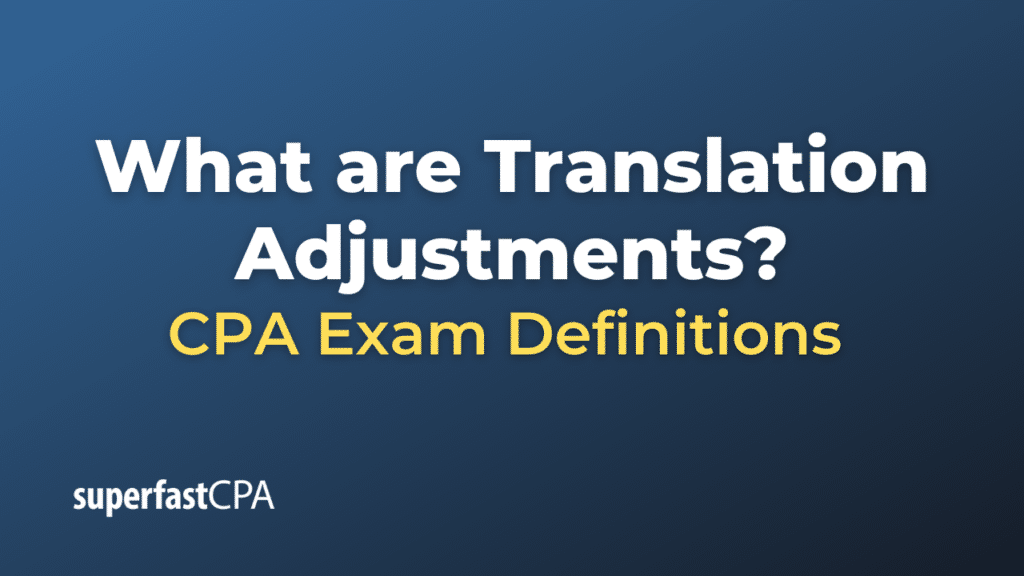Translation Adjustments
Translation adjustments arise when a company translates the financial statements of its foreign subsidiaries into its reporting currency to prepare consolidated financial statements. These adjustments are needed because exchange rates between currencies fluctuate, and a company must pick a specific method to translate its foreign subsidiary’s financial statements.
Here’s a simple breakdown:
- Types of Exchange Rates:
- Spot Rate: The rate of exchange on a specific date.
- Average Rate : An average of the exchange rates over a period of time (often used for income statement items).
- Historical Rate: The rate in effect at the time of a specific transaction or event.
- Translation Methods:
- Current Rate Method: All assets and liabilities are translated at the current exchange rate, and equity accounts are translated at historical rates. Any resulting difference goes into a separate component of equity called the “cumulative translation adjustment” (CTA) within accumulated other comprehensive income.
- Temporal Method : Monetary assets and liabilities are translated at the current exchange rate; non-monetary items are translated at historical rates. Revenue and expenses associated with non-monetary items (like COGS related to inventory) use the same historical rate as the related asset or liability, whereas other revenue and expenses use the average rate. Resulting translation adjustments hit the income statement, affecting net income.
- Cumulative Translation Adjustment (CTA):
- This is the balance that arises as a separate component of equity due to the differences when translating foreign financial statements. Under the current rate method, the translation adjustments don’t affect the income statement but instead are included in other comprehensive income (OCI) and accumulate in equity.
- Why it matters:
- It’s essential to recognize that translation adjustments are not “real” gains or losses in the sense that no cash changes hands and the operational performance of the company isn’t affected. Instead, they arise from the need to express financial statements in a single reporting currency.
- However, they can have a significant impact on a company’s reported equity and, under the temporal method, even on reported net income. Investors and analysts often take this into consideration when evaluating a company’s performance and financial position.
For companies that operate globally, understanding and managing the effects of currency translation is crucial, especially in volatile currency markets.
Example of Translation Adjustments
Let’s delve into a simple example of translation adjustments using the current rate method. For simplicity, we’ll limit our focus to a few balance sheet items.
Background:
- XYZ Inc., a U.S. company, has a subsidiary in Europe named EuroSub.
- At the beginning of the year, the exchange rate is $1.10/€.
- At the end of the year, the exchange rate changes to $1.20/€.
- During the year, EuroSub had net assets (assets minus liabilities) worth €10,000.
- During the year, EuroSub earned a net income of €1,000, which increased its net assets to €11,000 by year-end.
Translation at the Beginning of the Year:
EuroSub’s net assets = €10,000
Using the beginning of the year exchange rate ($1.10/€):
Translated net assets = €10,000 × $1.10/€ = $11,000
Translation at the End of the Year (Before considering income):
EuroSub’s beginning of year net assets = €10,000
Using the end of the year exchange rate ($1.20/€):
Translated net assets = €10,000 × $1.20/€ = $12,000
Considering Net Income:
Net income for EuroSub = €1,000
This increased EuroSub’s net assets to €11,000 by year-end.
Using the end of the year exchange rate:
Translated net assets at year-end = €11,000 × $1.20/€ = $13,200
Translation Adjustment:
Difference due to the exchange rate change on the beginning net assets: ($12,000 – $11,000) = $1,000
The total translated amount for net assets at year-end = $13,200 (including the income effect)
The expected translated amount without any exchange rate change (from beginning of the year) = $11,000 + ($1.10/€ × €1,000 net income) = $12,100
Translation Adjustment = $13,200 – $12,100 = $1,100
This $1,100 would be reported in the equity section of XYZ Inc.’s consolidated balance sheet as a “cumulative translation adjustment” within accumulated other comprehensive income.
Remember, this is a simplified example focusing only on net assets. In reality, every balance sheet item would be translated individually, and income statement items would typically be translated using an average rate for the period.













